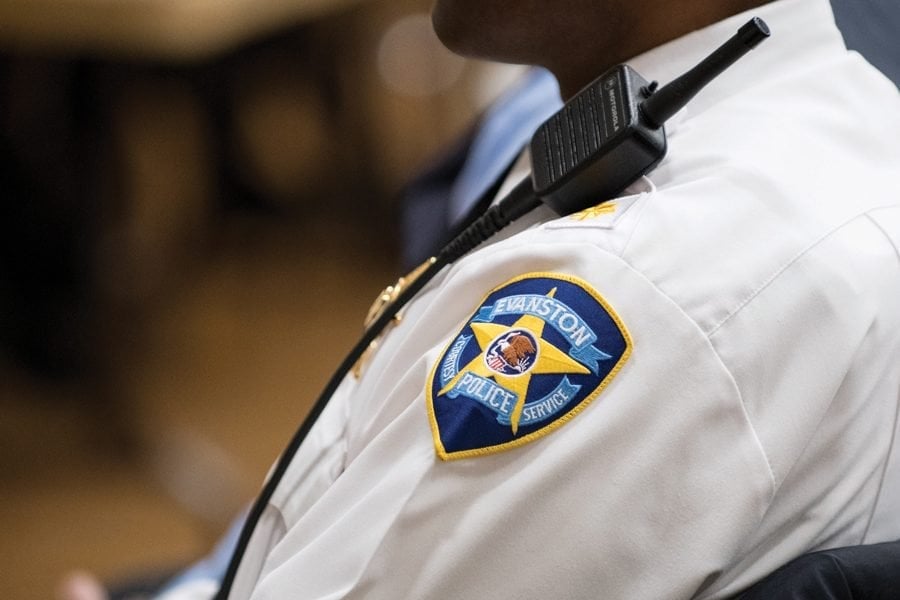Q&A: EPD Cmdr. Ryan Glew speaks about police response and communication on Clark Street Beach shooting
Daily file photo by Colin Boyle
The Evanston Police Department will add policing beats to downtown and the lakefront following a shooting at Clark Street Beach on Wednesday.
April 14, 2023
Content warning: This article contains mentions of gun violence.
Evanston Police Department Cmdr. Ryan Glew spoke with The Daily on Thursday about EPD’s response to the Wednesday shooting at Clark Street Beach and the communication to residents that followed.
This interview has been edited and condensed for clarity.
The Daily: When did EPD start communicating with Northwestern and University Police after responding to the incident?
Glew: There would have been communication on some level very early on as officers responded to that area and to the scene, and then as time went on, that communication would have been more between command staff of the two agencies. I think there were officers from Evanston and Northwestern University Police on the scene shortly after the incident.
The Daily: What does the communication between EPD and UP look like?
Glew: We’ll communicate with them what we’re doing and how we perceive things. But they’re going to have to make their own independent decision. So I know that I don’t know exactly when the conversation started, but I was present for a conversation between our two agencies — probably by about 9 o’clock at night — talking about how we were messaging and what we were ordering, and they made an independent determination on how to proceed.
The Daily: Why was the Evanston alert system Everbridge not deployed when the police responded to the incident?
Glew: The primary reason is the fact that (the shooting involved) a group of people that knew each other, not a random act. Their paths happened to cross at Clark Street Beach, and there was no indication of an active shooter. So that would have been the primary rationale for not issuing a shelter-in-place and not issuing an alert through the Everbridge system.
The Daily: In what kind of situation would the Everbridge system be employed?
Glew: When it is apparent that there is a situation where there is an active shooter or an immediate danger. It could be a weather event, or it could be a natural disaster or something where people need immediate direction, shelter-in-place or evacuation order for the preservation of their safety.
The Daily: How was the nearby community notified about the situation happening?
Glew: It was just through Twitter, and then our engagement with Northwestern media and the Chicagoland media for the 10 o’clock news cycle.
The Daily: How early should an alert go out to the public after police respond to an incident?
Glew: Talking about last night, it was about 35 or 40 minutes, I think, between the incident and the first Twitter post. We would ideally like that time to be a little bit tighter, getting credible information that’s thoughtful and gives the people the information that they need. We have to have the people here in place, and they have to be informed with the correct information to push that out. So that’s kind of what fills that time gap. So let’s say for instance, if there was an active shooter, you would get that early shelter-in-place active shooter, but then there would still probably be maybe a 20- or 30-minute gap before you start getting additional (information) like offender description or last direction of travel. For Twitter updates, we want to tighten up a little bit, maybe shave 10 or 15 minutes off a response like last night or maybe even a little bit more.
The Daily: Has EPD communicated with surrounding high schools?
Glew: We do have school liaison officers and resource officers at Evanston Township High School. They will engage with the ETHS staff directly to communicate appropriate information. We also have a good relationship with (Evanston/Skokie School) District 65 and try to disseminate the appropriate information to all the schools, especially when you have people that are victims (that) potentially have been students in the school system.
The Daily: Are there any initiatives EPD should take to make emergency alerts more accessible?
Glew: When it comes to messaging, we’re always going to have to improve that. I mean, every instance is going to be an opportunity for us to look at it, see what works when and what didn’t work. I think it’s important for the community to understand that, the community should know that. We always look at what information we can release and in a thoughtful manner, and we try to make every effort to get that information out to as many people as we can as quickly as possible. But we will always be searching for the next way to shrink the amount of people that we’re not reaching and tighten up those time frames to get the information out.
The Daily: What is EPD doing now to locate the suspects?
Glew: We are investigating and the North Regional (Major) Crimes Task Force is also assisting. So we are working diligently to identify the offenders, but we do not have any information released at this time and nobody’s in custody.
Email: shannontyler2025@u.northwestern.edu
Twitter: @shannonmtyler
Related Stories:



